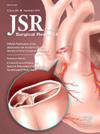Postoperative Wound Infection After Primary Closure in Pediatric Dog Bite Injuries
IF 1.7
3区 医学
Q2 SURGERY
引用次数: 0
Abstract
Introduction
Guidelines recommend three to 5 d of antibiotic prophylaxis after dog bite injury, but variation exists in clinical practice after primary closure of wounds. The purpose of this study was to analyze antibiotic duration and incidence of infection during a study period in which an institutional protocol limiting postrepair antibiotics to a maximum of 3 d was implemented.
Methods
Dog bite injuries that underwent primary closure in patients ≤18 y were retrospectively identified from 2018 to 2022 at a level 1 pediatric trauma center. Demographic and clinical data were collected. Protocol compliance and short course of antibiotics were defined as ≤3 d of antibiotics. Multivariable regression analysis for variables associated with wound infection was performed.
Results
455 injuries were included for analysis. After protocol implementation, the mean antibiotic duration decreased from 6.8 to 4.4 d (P < 0.001). Postrepair follow-up data were available for 235 (51.6%) cases in the cohort. Multivariable logistic regression identified superficial wounds and anatomic injury location to be significantly associated with wound infection. Shorter antibiotic duration was not associated with increased risk of wound infection on regression analysis, and there was no difference in postoperative wound infection rate between short-course and long-course groups (7.5% versus 7.1%, P = 0.912).
Conclusions
Standardization of postoperative antibiotic duration was associated with a decrease antibiotic duration without an increase in the incidence of wound infections after closure of dog bite wounds. This study highlights the feasibility of multidisciplinary standardization of pediatric trauma care across specialties and the safety of minimizing antibiotic duration after pediatric dog bite repairs.
小儿被狗咬伤初次缝合后的术后伤口感染。
导言:指南建议在被狗咬伤后使用三到五天的抗生素进行预防,但在伤口初次闭合后的临床实践中存在差异。本研究的目的是分析在研究期间抗生素的使用时间和感染发生率,在此期间,医院实施了修复后抗生素最多使用 3 天的规定:方法:回顾性地确定了2018年至2022年在1级儿科创伤中心接受初次闭合术的18岁以下患者的狗咬伤情况。收集了人口统计学和临床数据。协议合规性和抗生素短疗程定义为使用抗生素≤3 d。对与伤口感染相关的变量进行了多变量回归分析:共有 455 例伤口纳入分析。协议实施后,平均抗生素使用时间从 6.8 天减少到 4.4 天(P 结论:术后抗生素使用时间的标准化有助于减少伤口感染:术后抗生素使用时间的标准化与狗咬伤伤口缝合后抗生素使用时间的缩短有关,但伤口感染的发生率并未增加。这项研究强调了跨专业小儿创伤护理多学科标准化的可行性,以及在小儿狗咬伤修复术后尽量缩短抗生素使用时间的安全性。
本文章由计算机程序翻译,如有差异,请以英文原文为准。
求助全文
约1分钟内获得全文
求助全文
来源期刊
CiteScore
3.90
自引率
4.50%
发文量
627
审稿时长
138 days
期刊介绍:
The Journal of Surgical Research: Clinical and Laboratory Investigation publishes original articles concerned with clinical and laboratory investigations relevant to surgical practice and teaching. The journal emphasizes reports of clinical investigations or fundamental research bearing directly on surgical management that will be of general interest to a broad range of surgeons and surgical researchers. The articles presented need not have been the products of surgeons or of surgical laboratories.
The Journal of Surgical Research also features review articles and special articles relating to educational, research, or social issues of interest to the academic surgical community.

 求助内容:
求助内容: 应助结果提醒方式:
应助结果提醒方式:


